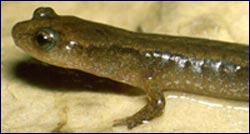Habitat microstructure drives salamander metamorphosis

Oklahoman salamander
Whether salamanders transform into their terrestrial, adult form or retain their aquatic, juvenile form depends on the nature of the streambed where they develop. A study published today in the open access journal BMC Biology reveals that the Oklahoma salamander Eurycea tynerensis metamorphoses into a more terrestrial adult form in streambeds composed of fine, tightly packed gravel but retains its juvenile, or paedomorphic, form in streambeds made of large, loosely packed particles. This study highlights how a simple difference in habitat microstructure can have a major influence on patterns of development, morphology and evolution.
Ronald Bonett and Paul Chippindale from the University of Texas at Arlington, Texas, USA, analysed the type, size and degree of sorting of streambed sediments for 22 populations, 11 paedomorphic and 11 metamorphic, of the plethodontid salamander E. tynerensis living on the Ozark Plateau in south-central North America.
Bonett and Chippindale’s results show that paedomorphic salamanders prevailed in streambeds made of large well-sorted gravel, whereas metamorphic salamanders were found where streambeds consisted of small, unsorted sediments. The authors found a strong negative correlation between small streambed sediments and paedomorphosis.
Bonett and Chippindale explain that large gravel creates porous streambeds with large spaces between particles, where aquatic paedomorphic salamanders can access sub-surface water during dry months. However, if these spaces are filled in by small particles, metamorphosis is the only way they can survive when surface streams dry-up.
Media Contact
More Information:
http://www.biomedcentral.comAll latest news from the category: Life Sciences and Chemistry
Articles and reports from the Life Sciences and chemistry area deal with applied and basic research into modern biology, chemistry and human medicine.
Valuable information can be found on a range of life sciences fields including bacteriology, biochemistry, bionics, bioinformatics, biophysics, biotechnology, genetics, geobotany, human biology, marine biology, microbiology, molecular biology, cellular biology, zoology, bioinorganic chemistry, microchemistry and environmental chemistry.
Newest articles

Bringing bio-inspired robots to life
Nebraska researcher Eric Markvicka gets NSF CAREER Award to pursue manufacture of novel materials for soft robotics and stretchable electronics. Engineers are increasingly eager to develop robots that mimic the…

Bella moths use poison to attract mates
Scientists are closer to finding out how. Pyrrolizidine alkaloids are as bitter and toxic as they are hard to pronounce. They’re produced by several different types of plants and are…

AI tool creates ‘synthetic’ images of cells
…for enhanced microscopy analysis. Observing individual cells through microscopes can reveal a range of important cell biological phenomena that frequently play a role in human diseases, but the process of…





















